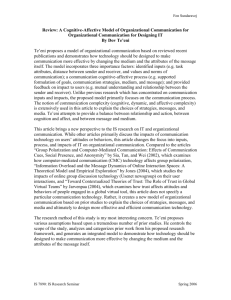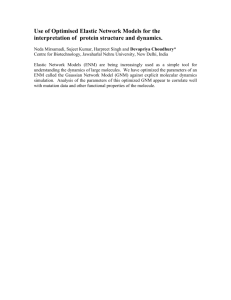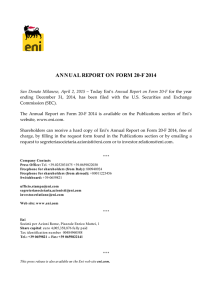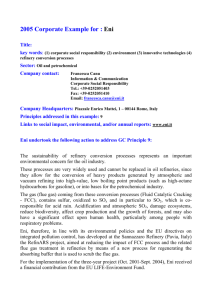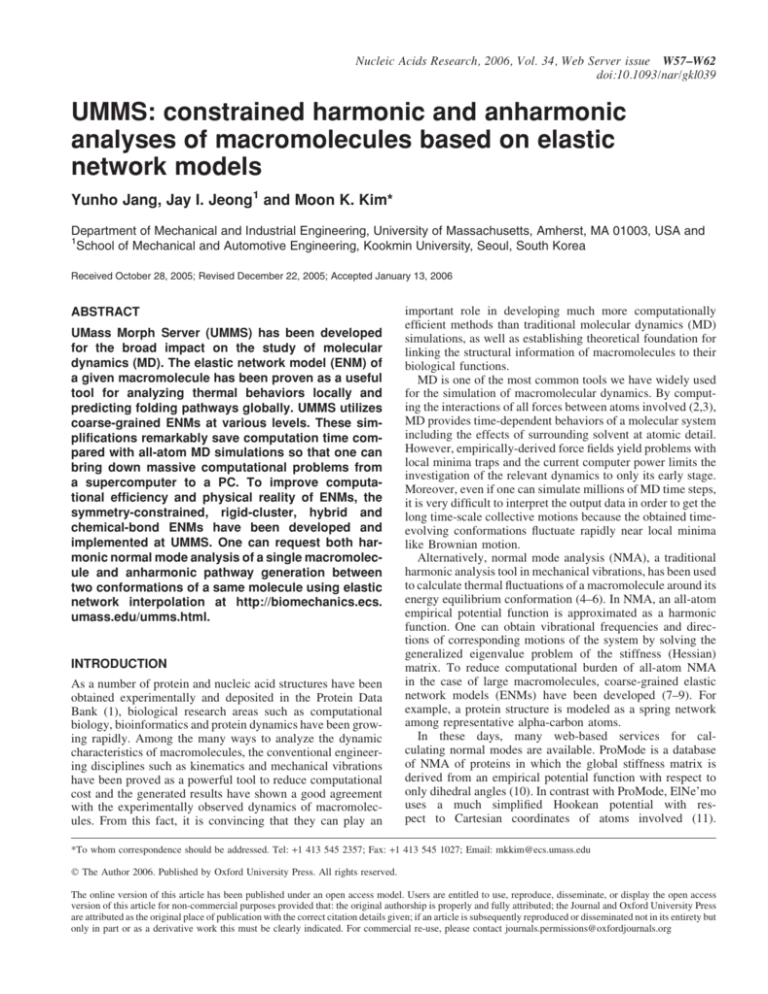
Nucleic Acids Research, 2006, Vol. 34, Web Server issue W57–W62
doi:10.1093/nar/gkl039
UMMS: constrained harmonic and anharmonic
analyses of macromolecules based on elastic
network models
Yunho Jang, Jay I. Jeong1 and Moon K. Kim*
Department of Mechanical and Industrial Engineering, University of Massachusetts, Amherst, MA 01003, USA and
1
School of Mechanical and Automotive Engineering, Kookmin University, Seoul, South Korea
Received October 28, 2005; Revised December 22, 2005; Accepted January 13, 2006
ABSTRACT
UMass Morph Server (UMMS) has been developed
for the broad impact on the study of molecular
dynamics (MD). The elastic network model (ENM) of
a given macromolecule has been proven as a useful
tool for analyzing thermal behaviors locally and
predicting folding pathways globally. UMMS utilizes
coarse-grained ENMs at various levels. These simplifications remarkably save computation time compared with all-atom MD simulations so that one can
bring down massive computational problems from
a supercomputer to a PC. To improve computational efficiency and physical reality of ENMs, the
symmetry-constrained, rigid-cluster, hybrid and
chemical-bond ENMs have been developed and
implemented at UMMS. One can request both harmonic normal mode analysis of a single macromolecule and anharmonic pathway generation between
two conformations of a same molecule using elastic
network interpolation at http://biomechanics.ecs.
umass.edu/umms.html.
INTRODUCTION
As a number of protein and nucleic acid structures have been
obtained experimentally and deposited in the Protein Data
Bank (1), biological research areas such as computational
biology, bioinformatics and protein dynamics have been growing rapidly. Among the many ways to analyze the dynamic
characteristics of macromolecules, the conventional engineering disciplines such as kinematics and mechanical vibrations
have been proved as a powerful tool to reduce computational
cost and the generated results have shown a good agreement
with the experimentally observed dynamics of macromolecules. From this fact, it is convincing that they can play an
important role in developing much more computationally
efficient methods than traditional molecular dynamics (MD)
simulations, as well as establishing theoretical foundation for
linking the structural information of macromolecules to their
biological functions.
MD is one of the most common tools we have widely used
for the simulation of macromolecular dynamics. By computing the interactions of all forces between atoms involved (2,3),
MD provides time-dependent behaviors of a molecular system
including the effects of surrounding solvent at atomic detail.
However, empirically-derived force fields yield problems with
local minima traps and the current computer power limits the
investigation of the relevant dynamics to only its early stage.
Moreover, even if one can simulate millions of MD time steps,
it is very difficult to interpret the output data in order to get the
long time-scale collective motions because the obtained timeevolving conformations fluctuate rapidly near local minima
like Brownian motion.
Alternatively, normal mode analysis (NMA), a traditional
harmonic analysis tool in mechanical vibrations, has been used
to calculate thermal fluctuations of a macromolecule around its
energy equilibrium conformation (4–6). In NMA, an all-atom
empirical potential function is approximated as a harmonic
function. One can obtain vibrational frequencies and directions of corresponding motions of the system by solving the
generalized eigenvalue problem of the stiffness (Hessian)
matrix. To reduce computational burden of all-atom NMA
in the case of large macromolecules, coarse-grained elastic
network models (ENMs) have been developed (7–9). For
example, a protein structure is modeled as a spring network
among representative alpha-carbon atoms.
In these days, many web-based services for calculating normal modes are available. ProMode is a database
of NMA of proteins in which the global stiffness matrix is
derived from an empirical potential function with respect to
only dihedral angles (10). In contrast with ProMode, ElNe’mo
uses a much simplified Hookean potential with respect to Cartesian coordinates of atoms involved (11).
*To whom correspondence should be addressed. Tel: +1 413 545 2357; Fax: +1 413 545 1027; Email: mkkim@ecs.umass.edu
The Author 2006. Published by Oxford University Press. All rights reserved.
The online version of this article has been published under an open access model. Users are entitled to use, reproduce, disseminate, or display the open access
version of this article for non-commercial purposes provided that: the original authorship is properly and fully attributed; the Journal and Oxford University Press
are attributed as the original place of publication with the correct citation details given; if an article is subsequently reproduced or disseminated not in its entirety but
only in part or as a derivative work this must be clearly indicated. For commercial re-use, please contact journals.permissions@oxfordjournals.org
W58
Nucleic Acids Research, 2006, Vol. 34, Web Server issue
The rotation-translation block (RTB) approximation is
uniquely implemented to solve the limitation of the size of
system. Three other online servers MoViEs (12), WEBnm (13)
and iGNM (14) are launched recently to perform various
types of structural analyses including NMA and B-factor calculation. NMA has been also used to refine docked protein–
ligand and protein–DNA structures (15).
However, NMA is not able to predict anharmonic and large
pathways because the ensuing prediction of motions only
occurs near the equilibrium state. For conformational transitions between meta-stable conformations, several interpolation strategies such as linear interpolation, internal variable
interpolation and elastic network interpolation (ENI) have
been used. ENI is a purely geometry-based technique
developed by the author (16,17). The essence of ENI is to
uniformly interpolate the distances in two different conformations within the context of the coarse-grained ENM.
Currently the most widely used morph server is the ‘Database of Macromolecular Movements’ run by Gerstein at Yale
University (http://www.molmovdb.org/) (18). This server has
used the adiabatic mapping in which predetermined hinge or
shear regions in macromolecules are linearly interpolated and
each iteration step is followed by energy minimization of
the computed intermediate conformations to produce chemically reasonable morphs.
Although the conventional coarse-graining techniques
substantially reduce the degrees-of-freedom of the system,
harmonic and anharmonic analyses for large macromolecules
such as GroEL-GroES complex, virus capsid and ribosome are
still impracticable in a PC (19). Motivated by this situation,
we introduce further simplified models such as symmetryconstrained, rigid-cluster, hybrid and chemical-bond based
ENMs. These new features can bring down massive computational problems, which have been traditionally solved in a
supercomputer, to a PC level. For more details, see the
following section of applications.
As the demand on computational (theoretical) approaches to
MD has increased, we have developed UMass Morph Server
(UMMS) to provide one with both harmonic and anharmonic
analysis tools online. UMMS cannot only cross-validate the
results of other morph servers based on NMA (10–14) and
other interpolation techniques (18), but also provide several
unique features described above to improve computational
efficiency and physical reality of the models.
One of the important features of UMMS is that it has more
user-oriented interface than other servers do. For example,
UMMS allows one to override the default setting for both
the coarse-graining approaches (e.g. all-atom, backbone and
alpha-carbon only) and the spring connection (cutoff) rules.
In the case of NMA, specific cutoff distances are provided
for each coarse-grained method in order to generate an elastic
network mimicking both chemically bonded and non-bonded
interactions within a macromolecule. For instance, the range
from 8 to 16 s has been chosen empirically for an alphacarbon coarse-grained ENM to get the robust outputs in
NMA, which mathematically means that there are no more
than six zero eigenvalues. These cutoff values are somewhat
unrealistic (overestimated) compared with the actual van der
Waals interaction range. On the other hand, a relatively short
cutoff range from 5 to 8 s can be selected for a chemical-bond
ENM because there are additional backbone connections
modeled to stabilize the network (see Chemical-bond ENM
section).
Figure 2 illustrates the UMMS homepage, the graphic user
interface for query building, and the result windows from the
standard NMA and ENI, respectively. One can first browse the
NMA or ENI database of macromolecules posted on UMMS in
order to find one of interest. Then one can also submit the
query specifying its PDB name and simulation options. All of
requests are to be processed offline and the simulation results
will be uploaded to UMMS. The animated GIF movies and the
computed data files are downloadable at the server.
UMASS MORPH SERVER
Symmetry-constrained ENM
Figure 1 illustrates the flow chart of UMMS proposed here.
Once the server receives the request of NMA and/or ENI for a
particular macromolecule, the first step is to standardize the set
of coordinates of representative atoms. In ENI, a sequence
alignment is necessary to make sure that the given two sets
of coordinates have the same number of residues for the purpose of interpolation. Next, we can create the linking matrix
based on the input cutoff values. Using this geometry-based
elastic network, NMA and ENI will be performed. Finally, the
mode shapes calculated from NMA and the intermediate conformations morphed by ENI will be visualized with the 3D
molecular graphics program Rasmol (20).
The assembly of repeated units is one of the ways that nature
adopts to produce large macromolecular structures. For
example, most viruses adopt this strategy to reproduce their
protein shells called capsids. Only a short sequence of nucleic
acids is needed to encode a small repeated unit of a capsid.
Therefore, one can significantly reduce computational cost for
NMA or ENI of a symmetric system by using its symmetry
feature induced by the manner of assembly. This symmetryconstrained NMA and ENI have been applied for the study of
maturation process of the HK97 virus capsid (21). The degreeof-freedom of this symmetric system is reduced by the factor
of 60. The resulting symmetric normal modes explain the
APPLICATIONS
As aforementioned, NMA has been used to predict harmonic
fluctuations (i.e. flexibilities) of a single macromolecule at an
equilibrium conformation, whereas ENI has been used to generate anharmonic transition pathways between two different
conformations without any steric clashes. However, harmonic
and anharmonic analyses for large macromolecules may be
still impracticable in a PC because of memory limitation. In
addition, the current ENI method takes into account only geometric information with linear spring connections replacing
chemically oriented interactions between atoms. It means that
the computed pathways cannot be considered as time-evolving
motions like MD results, but be interpreted as plausible
conformational changes between two given conformers. The
following applications aim to not only simplify the current
ENMs but also get more realistic simulation results.
Nucleic Acids Research, 2006, Vol. 34, Web Server issue
W59
Figure 1. Schematic representation of the working procedure of UMMS. Harmonic NMA and anharmonic pathway generation can be performed based on user’s
requests. The default setting of coarse-graining method for protein is to take only alpha-carbon atoms per residue. Its resolution is probably enough to investigate the
global dynamics of proteins in most of cases. For small proteins (approximately <1000 atoms), backbone-trace ENMs including only heavy atoms along the protein
backbone and full-atom ENMs are also practicable in a PC. Regardless of the level of coarse-graining of ENMs, a single-parameter Hookean potential is defined in
Cartesian space and then differentiated resulting in the stiffness matrix for NMA. MD data interpretation and incorporation with experimental data such as FRET and
NMR are also available at UMMS. For more details, see the section of applications.
maturation mechanism of HK97 well, and show a good agreement with those obtained by expensive computation for the
whole capsid (22,23). UMMS can efficiently simulate the
dynamics of many other symmetric macromolecules, currently
impracticable in a PC, using this symmetry-constrained
method.
Rigid-cluster or hybrid ENM
Most of large conformational changes in macromolecules can
be resolved into collective motions such as hinge and shear
motions (18). For instance, the major conformational change
of HK97 is the capsid expansion induced by the shear motion
between skewed trimers in each asymmetric unit (24). Hence,
the rigid-cluster ENM can be applied to macromolecules in
which such collective motions occur during the transition (25).
The key idea is to only consider inter-connections among rigid
clusters defined from the standard ENM because intraconnections within a cluster are preserved under rigid-body
motions. The number of clusters and the size of each cluster
will be adjusted by the user’s preference between resolution
and efficiency.
In the case of a complex structure which contains both rigid
domains and flexible loop regions, the rigid-cluster ENM may
destroy the generality of the flexible parts of the system too
much. One can accommodate this problem by a hierarchical
modeling in which the flexible regions are represented with
higher resolution than other rigid regions (26).
The mathematical models for both rigid-cluster and hybrid
ENMs have been developed and also extended to symmetryconstrained systems (25). This computational advantage
enables UMMS to perform both harmonic and anharmonic
analyses of large macromolecules within reasonable time
(less than a day) in a PC.
MD data interpretation with NMA/ENI
One of the unique features provided by UMMS is MD data
interpretation. As mentioned in the introduction part, interpretation of a massive amount of MD data which just resemble
W60
Nucleic Acids Research, 2006, Vol. 34, Web Server issue
Figure 2. Overview of UMMS. The main page (middle panel) consists of NMA database, ENI database and query windows. One can not only browse NMA or ENI
database to access the existing result of a specific macromolecule of interest, but also request the analysis via the query windows. A typical NMA window (upper left
panels) shows animated mode shapes with various representations, the connectivity map of ENM called linking matrix, and the B-factor comparison plot. An ENI
window (upper right panels) presents the computed ENI pathway between the two end conformations. One can download both animations and data files (PDB and text
format) from those windows. Four different query windows (lower panels) are used for submitting the structural information of macromolecules (PDB ID, Cartesian
coordinate file, MD trajectory data, FRET distance data) and choosing the simulation parameters (coarse-graining method, cutoff rule, output representation type).
a series of Brownian motions is another painstaking task after
computationally expensive MD simulation. NMA and ENI can
act as a supplementary tool to interpret MD results with ease
(27). When MD trajectory data computed by Amber or
Charmm are provided through UMMS, we first test if the
given MD trajectory includes large and collective motions
by measuring root mean square deviation with respect to
the initial conformation. ENI can be applied to generate a
highly directed pathway between the two extreme MD conformers (i.e. one is the initial conformer and the other is the
farthest structure from the initial one). This pathway is considered as an ensemble of MD trajectory without random
Nucleic Acids Research, 2006, Vol. 34, Web Server issue
fluctuations along the way. One can also utilize NMA to interpret MD data. If there is no significant conformational change,
a reference structure is determined by finding the closest conformer to all other MD data on average. The displacement
errors of each MD conformer with respect to the reference
structure can be considered as thermal fluctuations. The
predicted lowest normal modes collaboratively capture
those fluctuations well. Consequently, NMA and ENI may
serve as a paradigm for reduced-DOF dynamic simulations
of large macromolecules as well as a method for the reducedparameter interpretation of MD data.
ENI incorporated with partial conformational data
ENI can also be extended to incorporate partial structural
information into computer simulation of macromolecular
motions. When the initial conformation and only partial
distance information for the target conformation are available,
a modified ENI method can serve as a prediction tool for
global motions that are consistent with conformational data
experimentally measured by fluorescent resonance energy
transfer (FRET) or NMR (16). In this method, any interresidue distance that is not specified in the target conformation
is allowed to relax unless it results in steric clashes during
the transition. The related mathematical description can be
found at our previous paper (16). Once partial information
about conformational change like FRET distance data is
provided through UMMS, those data are to be superimposed
onto the known crystal structure to examine the structural
implications of measured inter-residue distances for the
prediction of the second conformation.
Chemical-bond ENM
The distance-cutoff method, a traditional connection rule for
ENMs, sometimes fails to generate physically reliable results
due to the uncertainty of system stiffness and connectivity.
This model has limitation on representing the nature of chemical interactions in a real protein structure because a cutoff
distance is empirically chosen longer than the maximum range
to which atomic interactions can be felt. Therefore, the
resulting elastic network over-represents the global stiffness
of the system. To solve this discrepancy between the actual
interaction range of a real macromolecule and the virtual
spring connection range in an ENM, a chemical-bond ENM
has been proposed (28). First, four consecutive alpha-carbon
atoms along the protein backbone (ith through i + 3th representative atoms in a coarse-grained model) are linked to one
another. These constraints in Cartesian space replace 3N 6
internal coordinates including N 1 bond lengths, N 2
bond angles and N 3 torsion angles for an N-particle system.
These backbone connections stabilize the elastic network so
that the derived stiffness matrix cannot have more than six
zero eigenvalues which correspond to rigid-body motions. It
enables to reduce the cutoff distance down to the range of
van der Waals interactions in the chemical-bond ENM. Then,
the chemical-bond information such as disulfide bonds, hydrogen bonds and ionic bonds is utilized to add more spring
connections for the realism of output results. These chemical
bonds play an important role in characterizing the dynamics of
macromolecules. By testing several example proteins, it is
observed that the chemical-bond ENM is computationally
W61
more efficient as well as more robust than the other conventional models. NMA and ENI based on the chemical-bond
ENM are also available at UMMS.
CONCLUSIONS
We have introduced UMMS which can analyze harmonic
(NMA) and anharmonic (ENI) motions of macromolecules
based on various levels of coarse-grained ENMs. Since we
have exploited a lot of mathematical expressions (not
displayed here) to implement those sophisticated procedures,
it is probably difficult for some biologists who are not mathematically oriented to directly adopt the methodologies
presented here for their research topics. Therefore, we recently
launched a new online morph server called UMMS. Once one
requests the dynamic analysis for a specific macromolecule
through the server, we then perform it offline and post the
result on the server visually and numerically to share the
benefits of this work with the general public.
Our focus is also placed on the theoretical modification of
the standard coarse-grained NMA and ENI methods in order to
improve computational efficiency and physical realism with
aid of engineering disciplines such as robot kinematics, group
theory and mechanical vibrations.
Symmetry-constrained, rigid-cluster and hybrid models can
together bring down the high-dimensional problems to a PC
level. The chemical-bond ENM can generate more robust and
reliable network models. UMMS also provides two unique
services such as MD data interpretation and time-resolved
ENI. This online service will enhance scientific understanding
of the relationship between molecular structure and dynamics
(i.e. function) in a cost-effective fashion.
ACKNOWLEDGEMENTS
Funding to pay the Open Access publication charges for this
article was provided by the University of Massachusetts
Amherst.
Conflict of interest statement. None declared.
REFERENCES
1. Berman,H.M., Westbrook,J., Feng,Z., Gilliland,G., Bhat,T.N.,
Weissig,H., Shindyalov,I.N. and Bourne,P.E. (2000) The protein data
bank. Nucleic Acids Res., 28, 235–242.
2. Levitt,M. (1983) Molecular dynamics of native protein. I. Computer
simulation of trajectories. J. Mol. Biol., 168, 595–617.
3. Levitt,M. (1983) Molecular dynamics of native protein. II. Analysis and
nature of motion. J. Mol. Biol., 168, 621–657.
4. Brooks,B. and Karplus,M. (1983) Harmonic dynamics of proteins: normal
modes and fluctuations in bovine pancreatic typsin inhibitor. Proc. Natl
Acad. Sci. USA, 80, 6571–6575.
5. Scott,W.R.P., Hunenberger,P.H., Tironi,I.G., Mark,A.E., Billeter,S.R.,
Fennen,J., Torda,A.E., Huber,T., Kruger,P. and van Gunsteren,W.F.
(1999) The GROMOS biomolecular simulation program package.
J. Phys. Chem. A, 103, 3596–3607.
6. Tirion,M.M. and Ben-Avraham,D. (1998) Normal modes analyses of
macromolecules. Physica A, 249, 415–423.
7. Tirion,M.M. (1996) Large amplitude elastic motions in proteins from a
single-parameter, atomic analysis. Phys. Rev. Lett., 77, 1905–1908.
8. Atilgan,A.R., Durell,S.R., Jernigan,R.L., Demirel,M.C., Keskin,O. and
Bahar,I. (2001) Anisotropy of fluctuation dynamics of proteins with
an elastic network model. Biophys. J., 80, 505–515.
W62
Nucleic Acids Research, 2006, Vol. 34, Web Server issue
9. Bahar,I., Atilgan,A.R. and Erman,B. (1997) Direct evaluation of thermal
fluctuations in proteins using a single parameter harmonic potential.
Fold. Des., 2, 173–181.
10. Wako,H., Kato,M. and Endo,S. (2004) ProMode: A database of normal
mode analyses on protein molecules with a full-atom model.
Bioinformatics, 20, 2035–2043.
11. Suhre,K. and Sanejouand,Y.H. (2004) ElNe’mo: a normal mode
web server for protein movement analysis and the generation of
templates for moelular replacement. Nucleic Acids Res., 32,
W610–W614.
12. Cao,Z.W., Xue,Y., Han,L.Y., Xie,B., Zhou,H., Zheng,C.J., Lin,H.H. and
Chen,Y.Z. (2004) MoViES: molecular vibrations evaluation server for
analysis of fluctuational dynamics of proteins and nucleic acids.
Nucleic Acids Res., 32, W679–W685.
13. Hollup,S.M., Salensminde,G. and Reuter,N. (2005) WEBnm@: a web
application for normal mode analyses of proteins. BMC
Bioinformatics, 6, 52.
14. Yang,L.W., Liu,X., Jursa,C.J., Holliman,M., Rader,A.J., Karimi,H.A.
and Bahar,I. (2005) iGNM: a database of protein functional motions
based on Gaussian network. Bioinformatics, 21, 2978–2987.
15. Lindahl,E. and Delarue,M. (2005) Refinement of docked protein-ligand
and protein–DNA structures using low frequency normal mode amplitude
optimization. Nucleic Acids Res., 33, 4496–4506.
16. Kim,M.K., Jernigan,R.L. and Chirikjian,G.S. (2002) Efficient generation
of feasible pathways for protein conformational transitions.
Biophys. J., 83, 1620–1630.
17. Kim,M.K., Chirikjian,G.S. and Jernigan,R.L. (2002) Elastic models of
conformational transitions in macromolecules. J. Mol. Graph.
Model., 21, 151–160.
18. Gerstein,M. and Krebs,W. (1998) A database of macromolecular motions.
Nucleic Acids Res., 26, 4280–4290.
19. Wang,Y., Rader,A.J., Bahar,I. and Jernigan,R.L. (2004) Global ribosome
motions revealed with elastic network model. J. Struct. Biol., 147,
302–314.
20. Sayle,R.A. and Milnerwhite,E.J. (1995) RasMol: biomolecular graphics
for all. Trends Biochem. Sci., 20, 374–376.
21. Kim,M.K., Jernigan,R.L. and Chirikjian,G.S. (2003) An elastic network
model of HK97 capsid maturation. J. Struct. Biol., 143, 107–117.
22. Rader,A.J., Vlad,D.H. and Bahar,I. (2005) Maturation dynamics of
bacteriophage HK97 capsid. Structure, 13, 413–421.
23. Tama,F. and Brooks,C.L.,III (2005) Diversity and identity of mechanical
properties of icosahedral viral capsids studied with elastic network
normal mode analysis. J. Mol. Biol., 345, 299–314.
24. Conway,J.F., Wikoff,W.R., Cheng,N., DudaR.L., Hendrix,R.W.,
Johnson,J.E. and Steven,A.C. (2001) Virus maturation involving large
subunit rotations and local refolding. Science, 292, 744–748.
25. Kim,M.K., Jernigan,R.L. and Chirikjian,G.S. (2005) Rigid-cluster
models of conformational transitions in macromolecular machines and
assemblies. Biophys. J., 89, 43–55.
26. Doruker,P., Jernigan,R.L. and Bahar,I. (2002) Dynamics of large
proteins through hierarchical levels of coarse-grained structures.
J. Comput. Chem., 23, 119–127.
27. Kim,M.K., Li,W., Shapiro,B.A. and Chirikjian,G.S. (2003) A comparison
between elastic network interpolation and MD simulation of
16S ribosomal RNA. J. Biomol. Struct. Dyn., 21, 395–405.
28. Jeong,J.I., Jang,Y. and Kim,M.K. (2006) A connection rule for a-carbon
coarse-grained elastic network model using chemical bond information.
J. Mol. Graph. Model., 24, 296–306.

